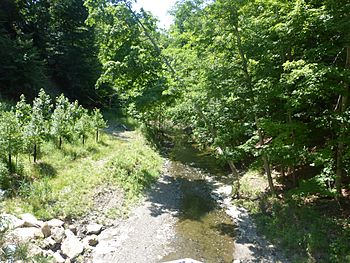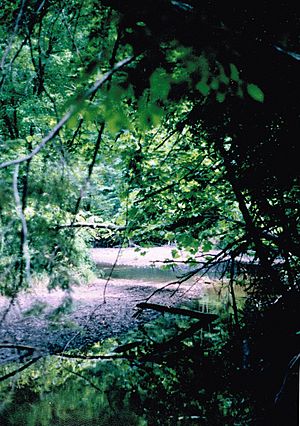Abram Creek (Ohio) facts for kids
Quick facts for kids Abram Creek |
|
|---|---|

Abram Creek at the NASA Glenn Research Center in Ohio. This photo looks upstream, close to where the creek joins the Rocky River.
|
|
| Country | United States of America |
| Cities | Berea, Brook Park, Cleveland, Middleburg Heights, Parma Heights |
| Physical characteristics | |
| River mouth | Rocky River in Brook Park, near NASA Glenn Research Center 41°25′04″N 81°51′59″W / 41.41778°N 81.86639°W |
| Length | 7.4 mi (11.9 km) |
| Basin features | |
| Basin size | 10.6 sq mi (27 km2) |
Abram Creek is a small stream in Cuyahoga County, Ohio. It flows into the Rocky River. The creek's watershed, which is the area of land that drains into it, covers about 10.6 square miles. This area includes parts of several cities like Berea, Brook Park, Cleveland, Middleburg Heights, and Parma Heights.
The land around Abram Creek is a mix of homes, businesses, and natural areas. Important places in its watershed include the Cleveland Hopkins International Airport and the NASA Glenn Research Center. Parts of the upper creek, including Lake Isaac and Lake Abram, are managed by the Cleveland Metroparks. Over time, people have changed the creek a lot. It went from being a large swamp to farmland, then a polluted stream, and now it's a mix of natural and developed areas.
Contents
History of Abram Creek
When the first white settlers arrived, much of the land around Abram Creek was a big swamp. This swamp was even known by the nickname "Podunk." For a while, some people made their own coins there, which became known as "Podunk money."
The creek and Lake Abram were named after Abram Hickox. He was the first blacksmith in Cleveland. His nephew, Jared Hickox, was the first white settler in Middleburg Township. Even though the land was swampy, it was very fertile. Much of it was drained to create farms. Starting in 1843, onions became the main crop in the area. Berea even became famous as the "Onion Capital of the Nation."
Airport Changes to the Creek
To make the runways at Cleveland Hopkins International Airport longer and safer, a part of Abram Creek was moved. This section of the creek now flows through four large concrete tunnels. These tunnels are 10 feet wide and about 3,800 feet long. They cover the entire path of the creek through the airport property. This big construction project started in 2002 and was finished in 2004.
Protecting Lake Abram
From the 1990s to 2013, the Cleveland Metroparks worked to buy land around Lake Abram. They also focused on the marshland between Lake Isaac and Lake Abram. This area is special because it's the last remaining "glacial pothole wetland" in Cuyahoga County. A wetland is a type of land that is often wet, like a swamp or marsh.
Through several land purchases, the Metroparks gained about 80 acres of land. In 2009, they completed the Lake-to-Lake Trail. This path, made of pavement and boardwalks, connects the two lakes. It allows visitors to explore and enjoy the natural area. Many people use this trail, with an estimated 40 to 50 people passing through every hour.
The Creek's Basin
Water Quality and Wildlife
The path and size of Abram Creek and its lakes have changed a lot over the years. Lake Abram, for example, used to be 50 to 60 acres in size. Now, it is only about 5 acres. Much of the creek has been straightened or put into culverts (tunnels).
In the past, there were big sources of pollution, like wastewater treatment plants. These plants, which discharged into Abram Creek, were closed in the 1990s. Also, runoff from de-icing chemicals used at the airport used to go into the creek. This runoff is now sent to a special treatment facility.
Even with these improvements, runoff from homes and businesses can still be a source of pollution. In 2012, a study looked at the creek's water quality. It found that conditions had improved since earlier studies. However, some areas still needed more work. The study also noted that the culverts at the airport block fish from moving between the lower and upper parts of the creek.






